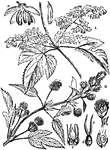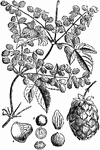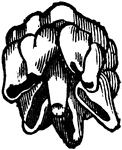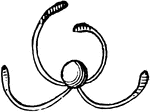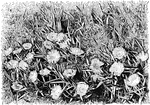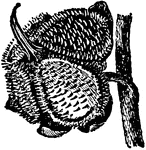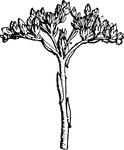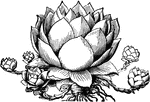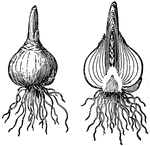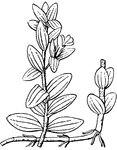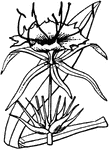188 illustrations of flowers and shrubs including: harebell, hawkweed, heartsease, heath, hemlock, hemp, hibiscus, holly, honeysuckle, hop, horehound, horsetail, houseleek, huckleberry, hydrangea, and hyssop

Common Hop
"Humulus Lupulus. 1. male flower; 2. female; 3. section of ovary; 4. ripe fruit; 5. section of it, showing…
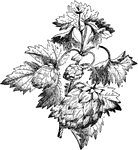
Hop
An illustration of the hop plant. Humulus, (hop) is a small genus of flowering plants, native to the…

Hops
The hop (Humulus) is a small genus of flowering plants, native to the temperate Northern Hemisphere.…
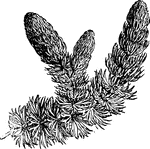
Hornwort
It is a slender aquatic herb, with whorled, finely dissected rigid leaves, and small solotary monoecious…
Horsetail
An illustration of a fertile branch of horsetail and spore of equisetum with unrolled elaters.
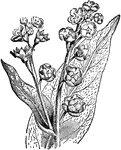
Hound's Tongue
Cynoglossum officinale (hound's tongue, dog's tongue, gypsy flower, and rats and mice due to its smell)…
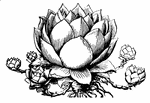
Houseleek
The houseleek is a fleshy plant, or succulent, which stores its nourishment in its leaves.
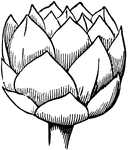
Houseleek
A young plant of the Houseleek, with the leaves (not yet expanded) numbered, and exhibiting the 13-ranked…
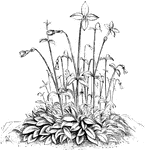
Houstonia Caerulea
The common name of houstonia caerulea is bluets. The flowers are usually a light blue color but they…
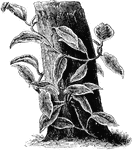
Hoya Carnosa Variegata
The common name of hoya carnosa is wax flower. This form has variegated leaves.

Flowering Stem of Hoya Carnosa
The common name of hoya carnosa is wax flower. The flowers are a pinkish white color. The flowers bloom…
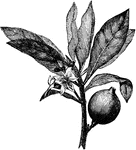
Huito
The Huito (Genipa americana) is a small tree with edible fruit in the madder family, Rubiaceae.

Humea Elegans
The flower heads of humea elegans are brownish red, pink, or crimson. The flowers bloom July to October.…

Portion of Female Inforlescence of Humulus Lupulus
The common name of humulus lupulus is hop or common hop. The flowers are greenish yellow. The flowers…

Common Hyacinth
Common hyacinth is the common name of hyacinthus orientalis. The flowers are fragrant and clustered.…

Double Flowered Variety of the Garden Hyacinth
The flowers of the double flowered garden hyacinth are small and rosette like. This variety is not cultivated…

Star of Bethlehem Hyacinth
Of the hyacinth family (Hyacinthaceae), the Star-of-Bethlehem or Ornithogalum umbellatum.
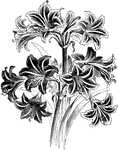
Hybrid Hippeastrums
Hippeastrums are native to tropical South America. The flowers range in color from red to white. Some…
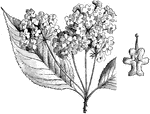
Inflorescence and Detached Flower of Hybrid Lantana
Hybrid forms of lantana are employed for greenhouse decoration and for bedding out purposes. Flowers…

Hydnora africana
The Hydnora africana is a parasitic plant growing in deserts known for giving of the odor of feces to…

Hydnora africana
The longitudinal section of the Hydnora africana is a parasitic plant growing in deserts known for giving…
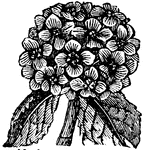
Hydrangea
This variety of plant is distributed widely and encompasses a wide variety of herbs. Hydrangea are cultivated…
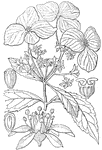
Hydrangea
"1. Hydrangeaa virens and its flower. 2. seed-vessel of H. hortensis; 3. its seed; 4. a section of it."…

Hydrangea arborscens
Compound cyme of Hydrangea arborescens, with neutral enlarged flowers round the circumference.
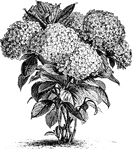
Hydrangea Hortensis
Hydrangea hortensis is the common hydrangea. The flowers vary in color according to the soil in which…
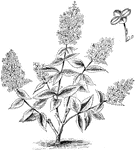
Habit and Detached Single Flower of Hydrangea Paniculata Grandiflora
Hydrangea paniculata grandiflora has white flowers. The flowers are small and star shaped. The flowers…
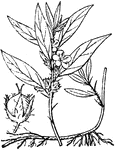
Hydrolea
Sepals united at base into a tube enclosing the ovary and later the fruit; leaves with spines in axils.

Flowering Stem of Hydrolea Spinosa
The flowers of hydrolea spinosa are pale blue. The flowers bloom in July. The stem is thorny.
